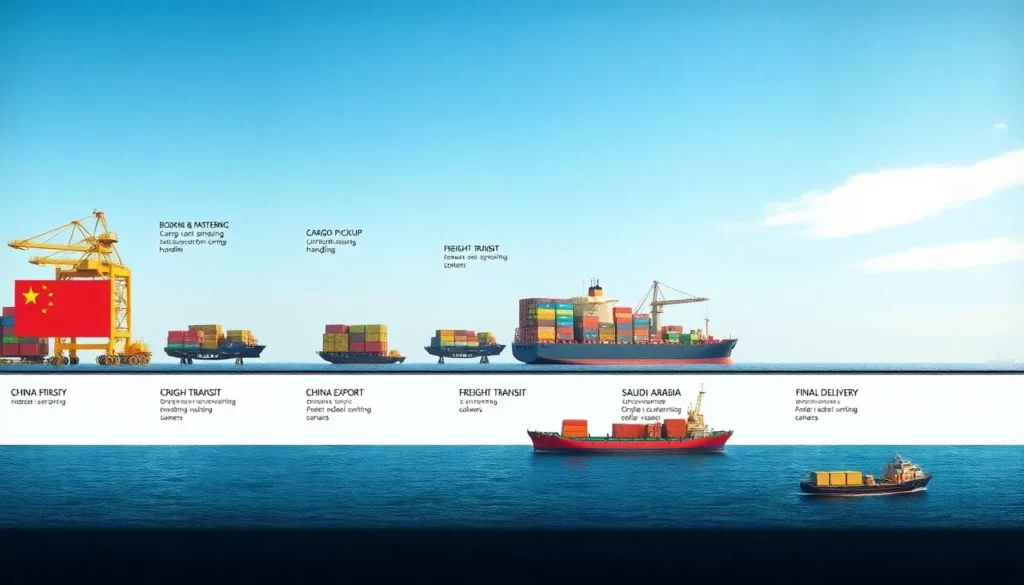Shipping from China to Saudi Arabia involves sea freight (18-40 days), air freight (3-7 days), or express courier (1-3 days). Success depends on proper SASO certification via the SABER platform, flawless documentation, and accounting for Saudi Arabia’s 15% VAT plus customs duties, which typically range from 5-20% of your goods’ value.
Choosing Your Shipping Method: A Strategic Comparison
Your first major decision is choosing the right mode of transport. This choice directly impacts your landed cost, delivery speed, and supply chain reliability. Each method serves a distinct strategic purpose, and understanding the trade-offs is the first step toward building a predictable and profitable import strategy.
| Feature | Sea Freight | Air Freight | Express Courier |
| Transit Time | Slow (18-40 days) | Fast (3-7 days) | Very Fast (1-3 days) |
| Cost Profile | Most economical for bulk | High | Highest per kilogram |
| Best For | Large, heavy, non-urgent goods | Urgent or high-value items | Small parcels & documents |
| Ideal Volume | Over 2 CBM or 300kg | 100kg to 500kg | Under 35kg |
The Bottom Line: Your choice depends entirely on your specific needs. Sea freight is your workhorse for planned inventory. Air freight is your solution for urgent restocks or high-value products. Express courier is for samples and critical documents where speed is the only factor that matters.
Sea Freight: For Cost-Efficiency and Bulk Shipments
Sea freight is the most economical choice for any large, heavy, or non-urgent cargo. When you’re moving substantial inventory, raw materials, or oversized items, ocean shipping delivers unmatched value. It’s the financial backbone of most supply chains sourcing from China.
- Key Benefit: Sea freight costs significantly less than air transport. For example, a 20-foot container costs between $1,150 to $1,900, while a 40-foot container is $1,400 to $2,650. This is a fraction of air freight’s typical $4-6 per kilogram price.
- Ideal Cargo: This method is perfect for bulk materials, large machinery, furniture, or high-volume stock orders where you can plan around longer transit times.
- Transit Time: Expect a port-to-port transit time of 18 to 40 days. The exact duration depends on your route and service, with direct routes from Ningbo to Dammam being among the fastest.
Strategic Decision: FCL vs. LCL
You need to understand that choosing between FCL (Full Container Load) and LCL (Less than Container Load) is a key financial decision. FCL means you rent an entire container for your exclusive use, while LCL means you share space with other importers. Think of it like choosing between a private taxi (FCL) and a shared bus (LCL)—one offers speed and security, the other offers lower upfront cost for smaller loads.
Pro Tip: Always book sea freight at least 3-4 weeks in advance, especially before major holidays like Chinese New Year or Ramadan. During these peak seasons, container space becomes scarce and rates can jump by 15-30%.

Air Freight: For Speed and High-Value Goods
Air freight prioritizes speed above all else, making it the fastest method for getting your goods from China to Saudi Arabia. When your business cannot afford the 3-6 week transit of sea freight, air transport becomes your strategic advantage.
- Cost: Air freight rates average around $5 per kilogram for shipments over 1,000kg. This premium buys you incredible speed and reliability for your most critical shipments.
- Ideal Cargo: This is essential for high-value electronics, perishable items, product samples, or urgent inventory restocks. If the cost of delay is higher than the cost of shipping, choose air freight.
- Transit Time: Expect a door-to-door delivery time of 1 to 8 days, including customs clearance. With proper documentation, this can be as fast as 3-5 days.
- Security: Air freight offers enhanced security and far less handling than sea freight, significantly reducing the risk of damage or theft during transport.
Pro Tip: For shipments between 100-300kg, the cost difference between air and LCL sea freight can be surprisingly small. Always request quotes for both options; you might find that arriving 2-3 weeks faster costs only a few hundred dollars more.
Express Courier: For Small Parcels and Documents
Express courier services like DHL, FedEx, or UPS provide a complete door-to-door service. They manage the entire logistics chain from pickup in China to final delivery at your address in Saudi Arabia, offering the simplest shipping experience.
- Best Use Case: Express shipping is the only practical choice for small packages, urgent documents, and samples, typically those weighing less than 35kg.
- Speed: This is the absolute fastest method, with shipments often arriving in just 1 to 3 days. This speed is achieved through highly streamlined and prioritized handling.
- Cost-Effectiveness: While the per-kilogram rate is high, express service is often the cheapest option for very light shipments. A 5kg sample might cost $100-150, which is more economical than the minimum charges associated with standard air freight.

The 6-Step Shipping Process from China to Saudi Arabia
Step 1: Booking & Partnering with a Freight Forwarder
Your journey begins with selecting a forwarder who has proven experience on the China-KSA trade lane. This partner is your key to navigating customs and avoiding costly delays. Provide them with your Commercial Invoice and Packing List early to ensure a smooth start.
Timeline Requirements: Book at least 2-4 weeks in advance for sea freight and 5-7 days for air freight. Remember that these lead times can double during peak seasons like the periods before Ramadan or Chinese New Year.
Step 2: Cargo Pickup & Origin Handling
Your forwarder will coordinate the pickup of goods from your supplier’s factory, managing the critical “first mile” of the shipment. This stage includes transport to the departure port or airport, temporary warehousing, and cargo inspection to verify contents match your documents.
Critical Check: You must ensure your supplier has used export-worthy packaging. Your cargo will endure a long journey with significant movement and potential temperature changes. Quality packaging and proper palletization are non-negotiable investments.
Step 3: China Export Customs Clearance
Next, your forwarder prepares and submits the necessary export declaration documents to Chinese customs. This step confirms your goods are legally permitted to leave China. Customs officials may inspect shipments to ensure compliance.
Remember This: Any discrepancy between your documents and the physical goods can cause significant delays at origin. This could cause you to miss your scheduled sailing or flight, creating a domino effect of complications.
Step 4: Freight Transit
Your goods are loaded onto the vessel or aircraft for their journey to Saudi Arabia. The carrier will issue a Bill of Lading (B/L) for sea freight or an Airway Bill (AWB) for air freight. This document is your receipt, contract, and proof of ownership. Your forwarder will provide tracking so you can monitor your shipment’s progress.
Step 5: Saudi Arabia Customs Clearance
This is the most critical and complex stage. Your forwarder’s partner in Saudi Arabia submits all required import documents to Saudi customs to have your goods cleared. Here, officials will assess duties and taxes and verify regulatory compliance.
Most Importantly: This is where the majority of shipping delays occur, almost always due to documentation errors or missing SASO certificates. The importer in Saudi Arabia must also have a valid Commercial Registration (import license) to clear the goods.
Step 6: Final Delivery
Once duties and taxes are paid and all documents are approved, Saudi customs releases your shipment. Your goods are then transported from the port or airport to your specified final destination. This “last-mile” delivery completes the international journey.
Pro Tip: Confirm your delivery address and contact details are 100% accurate on the Bill of Lading. A simple typo can lead to failed delivery attempts, storage fees, and unnecessary delays.

Mastering Saudi Customs: A Guide to Documents, Duties, and SABER
Navigating Saudi customs successfully comes down to meticulous preparation. A single error on a document can halt your entire shipment. Below is the definitive checklist to ensure a smooth clearance process.
The Definitive Documents Checklist for Saudi Customs
- Commercial Invoice
- Purpose: This is the primary document customs uses to determine the value of your goods and calculate duties and taxes.
- Key Requirements: It must be in Arabic or English, include accurate HS codes, and be attested by the Chamber of Commerce in China.
- Pro Tip: Ensure the value declared on your invoice matches the value declared to customs exactly. Even small discrepancies can trigger undervaluation investigations that delay your shipment for weeks.
- Packing List
- Purpose: This document details the contents, weight, and dimensions of each package, allowing customs to verify the physical goods against what you’ve declared.
- Key Requirement: Your Packing List must align perfectly with your Commercial Invoice. Any inconsistency is an immediate red flag for customs officials.
- Bill of Lading (B/L) or Airway Bill (AWB)
- Purpose: This is the legal contract of carriage between you and the shipping line or airline.
- Key Requirement: The document must include the Saudi importer’s Commercial Registration (CR) number and a valid mobile number for verification.
- Remember This: For sea freight, the original Bill of Lading acts as the document of title. Without it, you cannot claim your goods.
- Certificate of Origin (CO)
- Purpose: This certifies that your goods were manufactured in China, which is necessary for duty calculation.
- Key Requirement: Like the invoice, the CO must be attested by the Chamber of Commerce in China to be considered valid by Saudi customs.
- SASO Certificate of Conformity (CoC)
- Purpose: This is the most critical document. It proves your products meet mandatory Saudi standards and technical regulations.
- Key Requirement: This certificate is mandatory for all regulated products and must be obtained via the online SABER platform before shipping.
- Critical Warning: Do NOT ship your goods until you have confirmation that the required SASO certificates have been successfully issued in SABER. A shipment arriving without this will be held indefinitely and may be rejected.

A Deep Dive into the SABER System & SASO Certification
You need to understand that the SABER platform is Saudi Arabia’s mandatory online portal for all imports. This means every product entering the country must be registered and certified through this system, with no exceptions. Think of it like a digital gatekeeper for quality control—without the right electronic key (the SASO certificate), your goods will not be allowed to enter the country.
The Two-Certificate Process You Must Master
- Step 1: Product Certificate of Conformity (PCoC): This is issued for the product model itself and is valid for one year. The Saudi importer registers the product in SABER with its technical specifications.
- Step 2: Shipment Certificate of Conformity (SCoC): This is issued for each individual shipment. It links your specific shipment to the already-approved product registration (PCoC) and is the document customs requires for clearance.
Best Practice: The Saudi importer is responsible for initiating the SABER process. You must coordinate with your partner in Saudi Arabia long before the shipment departs to ensure all certifications are complete. Starting this process after the goods are already on the water is a recipe for disaster.
Understanding Duties, Taxes, and HS Codes
The final cost of your goods is heavily influenced by duties and taxes. You must understand that the Harmonized System (HS) Code is the 6-10 digit classification code that determines your product’s duty rate. This means that selecting the correct HS code is a critical financial task, as it directly impacts your total landed cost.
- Customs Duty: This typically ranges from 5% to 20% of your goods’ CIF value (Cost, Insurance, and Freight). Rates can change, so always verify the current duty for your specific product.
- Value Added Tax (VAT): This is applied at a flat 15% rate. Importantly, it is calculated on the total CIF value plus the customs duty paid.
For Example: A $10,000 shipment with a 10% duty rate would incur $1,000 in duties. The VAT would then be 15% of $11,000 ($1,650), making the total tax bill $2,650.
Prohibited & Restricted Items
Some goods are either completely banned or require special permission to enter Saudi Arabia.
- Prohibited Items: Alcohol, pork products, and narcotics will be seized and destroyed. There is zero tolerance.
- Restricted Items: Products like agricultural seeds or certain books require special permits from the relevant Saudi authorities before you ship them.
- Critical Labeling Rule: All products and their packaging must display an irremovable “Made in China” label. Using “Made in PRC” is not acceptable and can lead to customs rejection.

Managing Costs and Mitigating Common Shipping Risks
How to Read a Freight Quote & Avoid Hidden Costs
You need to understand that the initial freight quote you receive rarely represents your final shipping cost. This means you must dig deeper to see the full picture. Think of it like an airline ticket—the base fare is just the beginning, and you need to account for taxes, baggage fees, and other charges to know the true price.
- Core Components: Your quote includes the base freight rate, fuel surcharges, and origin/destination handling fees.
- Potential Hidden Costs: Always ask if your quote includes customs clearance fees ($150-500), port charges ($200-800), duties and taxes, and cargo insurance.
- Important Terminology: An FOB (Free On Board) quote means you pay for the international shipping. A CIF (Cost, Insurance, and Freight) quote means the seller has included shipping in the product price.
Actionable Advice: Always request a complete “landed cost” estimate from your forwarder. This should cover every single expense from your supplier’s door in China to your warehouse in Saudi Arabia, allowing for accurate budget planning.
Problem-Solving: Top 3 Shipping Delays and How to Prevent Them
In my two decades of helping importers, I’ve consistently observed that nearly all catastrophic delays stem from a few preventable errors.
Risk #1: Crippling Delays from Documentation Errors
- The Cause: Missing SASO Certificates, invoices that don’t match packing lists, or incorrect HS codes account for over 80% of customs holds.
- The Real Impact: A single error can hold a shipment for weeks, racking up $150-300 per day in port storage fees.
- The Solution: Use the Definitive Documents Checklist in this guide. Triple-check every document before your goods leave China and partner with a forwarder who specializes in Saudi requirements.
Risk #2: Improper Labeling & Packaging
- The Cause: Failure to include the mandatory “Made in China” label or using packaging that cannot withstand the journey.
- The Hidden Cost: Rejected shipments may need to be re-exported at your expense or destroyed, resulting in a total loss of the goods and all shipping costs.
- The Solution: Provide your supplier with exact labeling instructions. Invest in export-grade packaging and professional palletization, especially for sea freight.
Risk #3: Shipping During Peak Seasons
- The Cause: Shipping right before Chinese New Year (Jan/Feb) or during the pre-Ramadan rush leads to container shortages, rolled shipments, and severe port congestion.
- The Market Reality: Peak season can increase shipping costs by 15-30% while extending transit times by 7-14 days.
- The Solution: Plan your inventory needs far in advance. Book shipments 4-6 weeks ahead during these periods and communicate constantly with your forwarder.

Conclusion
Successfully shipping from China to Saudi Arabia hinges on three things: choosing the right shipping method for your needs, mastering the SABER platform for SASO certification, and ensuring perfect documentation. Sea freight offers cost efficiency for bulk goods, while air freight provides critical speed for urgent cargo. With a 15% VAT plus duties, accurate cost calculation is vital for your success.
Most Importantly: The difference between a smooth delivery and a costly nightmare is your logistics partner. An experienced freight forwarder anticipates challenges, ensures compliance, and manages the entire complex process, transforming your supply chain from a burden into a powerful competitive advantage.
Frequently Asked Questions
1. How long does it typically take to ship from China to Saudi Arabia?
Sea freight generally takes 18-40 days depending on the route. Air freight is much faster, requiring 3-7 days including customs clearance, while express courier services can deliver small packages in just 1-3 days.
2. What is the most important document I need for Saudi customs?
The SASO Certificate of Conformity (CoC) is the most critical document. It is mandatory for all regulated imports and must be obtained via the SABER platform before shipping. Without a valid SASO certificate, customs will not release your goods.
3. Is it cheaper to ship FCL or LCL?
FCL (Full Container Load) is more cost-effective per unit for larger shipments, as you pay a flat rate. LCL (Less than Container Load) has a lower upfront cost for smaller shipments but a higher rate per cubic meter. The break-even point is typically around 15-18 cubic meters.
4. Do I absolutely need a freight forwarder to ship from China?
While not legally required, it is highly recommended. The complexities of SASO certification, customs procedures, and documentation are significant. An experienced forwarder prevents costly mistakes and ensures you comply with all regulations.
5. What are the most common hidden costs I should watch out for?
Common extra charges include customs clearance fees ($150-500), port handling charges ($200-800), and detention/demurrage fees if your container is not returned on time. Always request a comprehensive “landed cost” estimate to avoid surprises.


